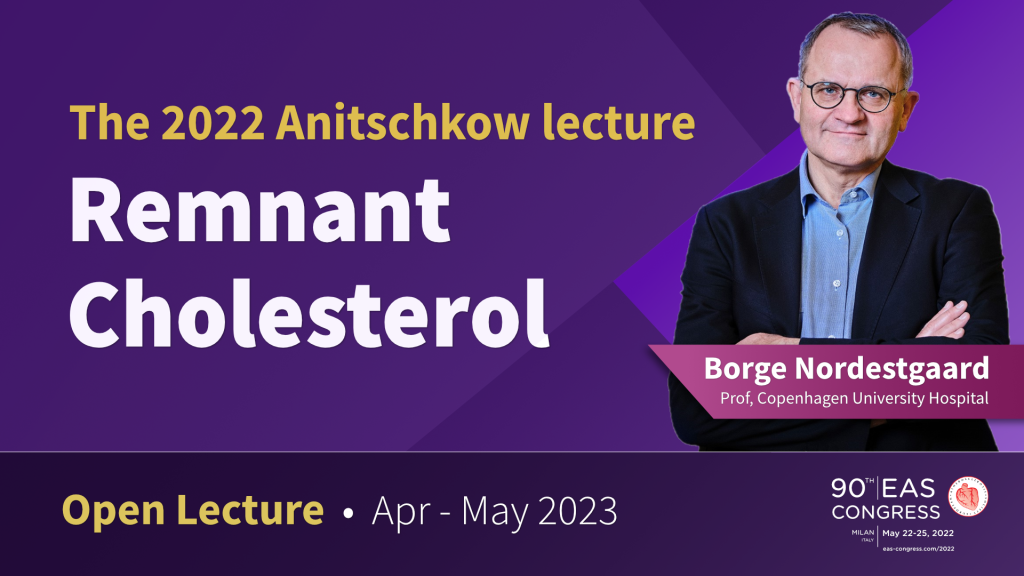EAS Academy Newsletter March 30, 2023
Featured Open Lecture: Anitschkow Lecture by Prof Børge Nordestgaard from EAS Congress 2022

This lecture was given by Professor Børge Nordestgaard, MD, DMSc as his Anitschkow Award lecture at the 90th EAS Congress in Milan Italy, in 2022.
Børge G. Nordestgaard is a Professor of Genetic Epidemiology at, the University of Copenhagen, and since 1999, Chief physician, Clinical Biochemistry, at Herlev Hospital, Copenhagen University Hospital, Denmark. He obtained his medical degree in 1985 and subsequently undertook postgraduate studies at Rigshospitalet, Copenhagen, and 2-year fellowships with Professor Donald Zilversmit at Cornell University in New York, and Professor Barry Lewis at St. Thomas’ Hospital, London University, UK. He was awarded his doctorate from the University of Copenhagen in 1990.
In his most important research contributions, Professor Nordestgaard utilized the strengths of large-scale prospective observational population studies, randomized intervention trials (JUPITER, PROMINENT, and HORIZON), and genetic epidemiology to investigate the association of biochemical and genetic biomarkers with human disease, especially cardiovascular disease. Collaborations with the Copenhagen City Heart Study, the Emerging Risk factor Collaboration, the JUPITER Trial, the UK Biobank, several large multinational consortia within cancer and pulmonary research, and several large cohorts of patients from the Copenhagen area including the entire Danish population via Statistics Denmark have been foundational to his studies. In 2003 he founded the Copenhagen General Population Study, which now includes more than 150,000 participants.
In the present lecture, Professor Nordestgaard presents his research on triglyceride-rich lipoproteins, including remnant lipoproteins, in the causal pathway of atherosclerosis. Professor Nordestgaard has shown that levels of non-fasting triglycerides above 5 mmol/L are associated with an increased risk of myocardial infarction, stroke, and all-cause mortality. Using a Mendelian randomization strategy, Professor Nordestgaard demonstrated the impact of genetic variants influencing the expression of key proteins involved in triglyceride metabolism on the associated risk for atherosclerotic cardiovascular disease. These findings have been pivotal to the consideration of lipid-lowering therapy for elevated triglycerides and remnant lipoprotein cholesterol to prevent cardiovascular disease, as well as the development of novel therapeutic agents for the management of elevated triglycerides.
To the Open Lecture by Prof. Børge NordestgaardEAS Education: Webinar “Update on the impact of nutrition on ASCVD”, March 30

Today is going to be the next EAS webinar. The optimal dietary interventions intended to prevent ASCVD remain a hot topic. We will start at 17:00 CET. Don’t miss out this opportunity to be up-to-date with ASCVD.
The webinar is open-access. Register now for free:
EAS 90th Congress: Plenary session: Lipoproteins revisited. What has changed?
ApoB – friend and foe, by Jan Kuivenhoven

Cholesterol-rich apolipoprotein (apo) B-containing lipoproteins, of which low-density lipoprotein (LDL) is the archetypal representative, play a fundamental role in the genesis and promotion of atherosclerosis.
Mechanistic and genetic studies suggest that assessment of the atherogenic particle subpopulations (LDL and very-low-density lipoprotein [VLDL]) rather than their lipid content may be a better predictor of cardiovascular risk. Alternatively, with accumulating evidence that apoB is integral to lipoproteins exerting their causal effect on risk for cardiovascular disease, measurement of apoB may be preferable.
While LDL cholesterol is conventionally used as a predictor of cardiovascular risk, its use is not without issues, especially when calculated measures of LDL cholesterol are used. In individuals with diabetes or metabolic syndrome, LDL cholesterol levels may not reflect the atherogenicity of the abnormal lipid profile associated with elevated triglyceride-rich lipoproteins. In these patients, apoB is a more accurate measure of risk rather than the concentration of cholesterol contained in lipoproteins. Evidence from epidemiologic studies also supports apoB as a better predictor of cardiovascular risk and response to treatment than measurement of LDL cholesterol. These findings make a case for considering apoB as a priority lipid target in prevention of cardiometabolic disease.
Although improvement in standardization and accessibility is needed, the totality of evidence supports apoB for both risk assessment and as a treatment target in routine clinical practice.
To the presentation: ApoB – friend and foeEmerging therapies for dyslipidemia, by Daniel Gaudet

Low-density lipoprotein cholesterol (LDL-C) is undoubtedly the priority target for lipid lowering therapy to prevent atherosclerotic cardiovascular disease (ASCVD).
However, despite maximally tolerated LDL-C lowering, including PCSK9-directed therapies, residual cardiovascular risk persists. Advances in human genetics enabling the identification of rare genetic variants with strong effects on ASCVD risk not only accelerated the development of therapies for severe dyslipidaemia, but also led to identification of novel pathways involved in the metabolism of other atherogenic lipoproteins, most notably triglyceride rich lipoproteins. These insights were critical to the application of a Mendelian randomization design to establish elevated plasma levels of these lipoproteins, as well as lipoprotein(a) [Lp(a)], as independent causal risk factors for ASCVD and thus potential contributors to residual risk. Understanding the underlying genetic and cell machinery has also provided impetus in treating rare dyslipidaemias.
The development of novel antisense therapies, including oligonucleotides and short interfering RNA-based strategies, addresses several unmet medical needs in lipidology. Among these treatments, those targeting apolipoprotein C-III or angiopoietin-like protein 3 have demonstrated substantial lowering of plasma triglycerides in the setting of moderate to severe hypertriglyceridaemia.
Despite the potential efficacy of these new therapies in ASCVD prevention, cost is likely to be prove a major obstacle to their clinical use. Affordability and access are therefore the key challenges facing the next generation of lipid-lowering agents in the era of precision medicine.
To the presentation: Emerging therapies for dyslipidemiaLp(a): The next frontier, by Sotirios Tsimikas

Following decades of debate, lipoprotein(a) [Lp(a)] is now recognised as a causal risk factor for atherosclerotic cardiovascular disease and aortic valvular stenosis, supported by evidence from genetic, epidemiological and mechanistic studies. Until recently, however, final proof of causality has proved elusive as the available lipid lowering therapies either have minimal effect on Lp(a) or effects on multiple lipoproteins. The emergence of novel antisense treatments that specifically inhibit the synthesis of apolipoprotein(a) offers the key to addressing this enigma.
Advances in antisense oligonucleotide development, notably conjugation with N-acetylgalactosamine to direct the therapy specifically to hepatocytes, has resulted in improved affinity and selectivity. In phase 2 trials, this agent reduced Lp(a) levels by up to 80%, providing a basis for further development to investigate the impact of Lp(a) lowering on cardiovascular events. The major outcomes study Lp(a)HORIZON (Assessing the Impact of Lipoprotein(a) Lowering With TQJ230 on Major Cardiovascular Events in Patients With CVD) with the apolipoprotein (a) antisense oligonucleotide pelacarsen is testing the Lp(a) hypothesis in secondary prevention patients with elevated Lp(a) levels and optimally managed of low-density lipoprotein cholesterol levels.
This trial will be pivotal to bridging the final frontier: Is Lp(a)-associated risk abolished by potent Lp(a) lowering? If proven, the results of Lp(a)HORIZON will be crucial for the development of paradigms aiming to improve awareness, diagnosis, and management of elevated Lp(a).
To the presentation: Lp(a): The next frontierTrigylcerides: From systemic to cellular metabolism, by Ira Goldberg

Whether elevated triglycerides, a surrogate for triglyceride [TG]-rich lipoproteins and their remnants, are associated with risk for cardiovascular disease, has engendered much debate over the decades. Current thinking, largely driven by insights from genetic studies, supports this association although definitive proof is still lacking from major outcomes studies. In addition, the underlying mechanisms of the atherogenicity of TG-rich lipoproteins merit further study. Given that lipoprotein lipase (LpL) plays a central role in TG metabolism, and those genes that modulate its activity correlate with the risk of cardiovascular disease events, research has focused on LpL biology to address this latter question.
ElucidatIon of the structure of the LpL active protein and its interaction with other post-translational regulators has been an important step. Studies showing that LpL is active as a monomer challenged thinking that LpL inhibitors like angiopoietin-like 4 (ANGPTL4) and stabilizers like lipid maturation factor 1 (LMF1) act by disrupting or maintaining LpL in dimer form. These insights prompted interest in developing targets to block LpL to reduce circulating TG levels.
Involvement of LpL in the intravascular hydrolysis of TG-rich lipoproteins on the surface of capillary endothelial cells has driven research into the multiple pathways that mediate endothelial transit of lipids into tissues. There is evidence to suggest a role for receptor-mediated processes in the movement of lipoproteins into the sub-endothelial space. In addition, studies have identified factors that may influence endothelial barrier integrity and thus delivery of lipids.
Taken together, it is evident that improved understanding of TG regulation at the cellular level may offer new therapeutic potential for the management of elevated TG to reduce residual risk.
To the presentation: Trigylcerides: From systemic to cellular metabolismEAS Congress 2023: Register with Regular fees and book your hotel with the best rates

The #EASCongress2023 is approaching and it’s time to secure your seat in Mannheim! Register for the event, with Regular fees and then book your hotel through our official accommodation partner to benefit from the best rates and personal assistance.
To registrationTo book your hotel